It's been ages since I've posted here—I've been more and more involved with the Catalan independence movement—and I've officially changed my website to include all of my different writing projects. I still plan to return to tech writing, and I'm fascinated with how technology, and particularly social media and direct connections have been key to winning Catalan independence. Stay tuned!
From here on, you can find me at lizcastro.com
Thanks!
Sunday, October 8, 2017
Tuesday, April 7, 2015
Twitter's new, improved quoted retweets
At the beginning, you could retweet in order to share someone else's tweet with your followers. To my knowledge, it wasn't Twitter's idea, but it came out spontaneously because it was necessary. It was a manual operation that placed an RT at the beginning of the tweet, which followed essentially intact.
People began to use MT when they substantially modified a RT before republishing. Since an RT was essentially a quote, if you changed the quote, it seemed like good practice to notify readers about the change.
At some point—maybe a year ago?—Twitter changed it so that a retweet no longer appeared with the letters RT, instead, the retweeter's Twitter profile appeared just above the tweet so that you could see who retweeted. That allowed Twitter to combine many RTs into a single line, since they could say Joe, Suzy, and Laura retweeted the following tweet.
If you manually quoted a tweet (only available on iOS as far as I could tell), Twitter would enclose the original tweet in quotation marks. Those of us who quote tweets a lot—to add comments, or in my case to translate—would manually remove the quotation marks, insert an initial RT or MT, and then add our own changes.
Yesterday, Twitter announced a new change to quoting tweets: now when you click the Retweet button, you have the option of adding comments, and when you do, you have 116 characters to do it with. That means Twitter is using up 24 characters for the citation, which comes out as a boxed image of the original tweet.
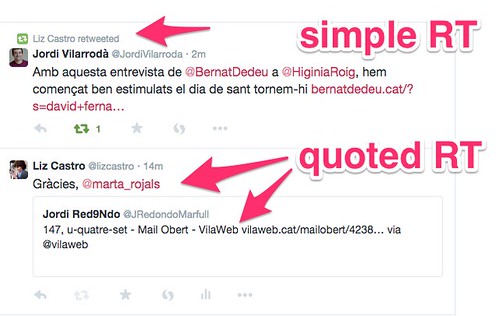
It's much better than the quotes but there are two small problems with it. First, we no longer have the option of retweeting with just a small change, perhaps an updated link or spelling correction, or added hashtag. That is, this is the only way to cite, unless you want to laboriously copy the original tweet and then create your own unlinked tweet, or reply. (On the other hand, it also makes it harder to commandeer someone else's tweet and post it as if it were your own.) Second, and more importantly for me, once you hit the RT button, on iOS you can't see the full text of the original, which is a problem if you're translating, or can't remember if it included the hashtag you wanted. The second problem is easily fixed, I hope they do.
This is a big change for people who quote (or translate) a lot of tweets, and have often wished they could 1) use more the space and not have to leave so much for the original hashtag or author and 2) because it will definitively distinguish regular RTs from commented ones, and maybe even clean up a timeline so that you can clearly see conversations about a single original tweet. Instead of the same tweet appearing many times, it will now appear once, with comments clearly delineated. Hopefully.
Update: I would swear that it wasn't working on desktop this morning, but now it seems to be.
Imagine this original tweet that I want to comment-tweet (and notice it contains an embedded Twitter card with photo):
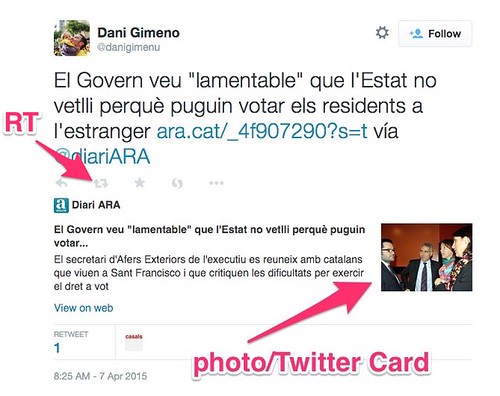
Click the RT button, and now you get a space where you can add comments:
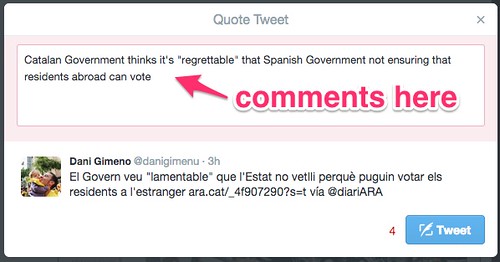
But that reveals another problem. When you comment a tweet, Twitter doesn't display the original URL's embedded Twitter card, or photo. Which is a big deal since tweets with photos get a lot more attention than those without.
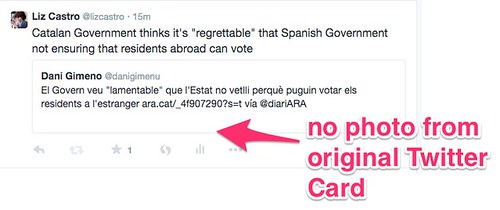
And in a Twitter feed, it doesn't show the Twitter Card (and photo) or even the text of the original tweet!
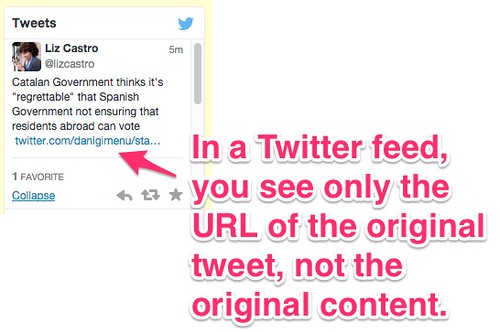
In some cases, you may be better off cooking your own.
People began to use MT when they substantially modified a RT before republishing. Since an RT was essentially a quote, if you changed the quote, it seemed like good practice to notify readers about the change.
At some point—maybe a year ago?—Twitter changed it so that a retweet no longer appeared with the letters RT, instead, the retweeter's Twitter profile appeared just above the tweet so that you could see who retweeted. That allowed Twitter to combine many RTs into a single line, since they could say Joe, Suzy, and Laura retweeted the following tweet.
If you manually quoted a tweet (only available on iOS as far as I could tell), Twitter would enclose the original tweet in quotation marks. Those of us who quote tweets a lot—to add comments, or in my case to translate—would manually remove the quotation marks, insert an initial RT or MT, and then add our own changes.
Yesterday, Twitter announced a new change to quoting tweets: now when you click the Retweet button, you have the option of adding comments, and when you do, you have 116 characters to do it with. That means Twitter is using up 24 characters for the citation, which comes out as a boxed image of the original tweet.

It's much better than the quotes but there are two small problems with it. First, we no longer have the option of retweeting with just a small change, perhaps an updated link or spelling correction, or added hashtag. That is, this is the only way to cite, unless you want to laboriously copy the original tweet and then create your own unlinked tweet, or reply. (On the other hand, it also makes it harder to commandeer someone else's tweet and post it as if it were your own.) Second, and more importantly for me, once you hit the RT button, on iOS you can't see the full text of the original, which is a problem if you're translating, or can't remember if it included the hashtag you wanted. The second problem is easily fixed, I hope they do.
This is a big change for people who quote (or translate) a lot of tweets, and have often wished they could 1) use more the space and not have to leave so much for the original hashtag or author and 2) because it will definitively distinguish regular RTs from commented ones, and maybe even clean up a timeline so that you can clearly see conversations about a single original tweet. Instead of the same tweet appearing many times, it will now appear once, with comments clearly delineated. Hopefully.
Update: I would swear that it wasn't working on desktop this morning, but now it seems to be.
Imagine this original tweet that I want to comment-tweet (and notice it contains an embedded Twitter card with photo):

Click the RT button, and now you get a space where you can add comments:

But that reveals another problem. When you comment a tweet, Twitter doesn't display the original URL's embedded Twitter card, or photo. Which is a big deal since tweets with photos get a lot more attention than those without.

And in a Twitter feed, it doesn't show the Twitter Card (and photo) or even the text of the original tweet!

In some cases, you may be better off cooking your own.
Thursday, March 26, 2015
Periscope - Twitter releases its own video streaming app
I've been hounding Periscope for a beta copy of their software from the moment I heard about it. It didn't help. Thank goodness (for them and me!) they released the program today and I was able to start testing it without bombarding them with any more bad poetry.
Curiously enough, I found out about Periscope as I was attending a conference on "Proximity Journalism" at the CosmoCaixa Auditorium in Barcelona. Live-streaming video seems a key component of proximity journalism, in my opinion.
For those of you who don't know, Meerkat and Periscope are applications which permit streaming video from the iPhone, and which permit some levels of sharing through Twitter.
I haven't yet tried Periscope out beyond Wifi coverage, but I'll do that in a few minutes. For now, here's what I've found, including similarities and differences with Meerkat. Thanks to Saül Gordillo who immediately downloaded both apps when I told him about them, and began to play with them in the row of seats right in front of me, allowing me to test a number of features.
Both apps work similarly. You open the app, optionally explain the video you're about to stream, and then begin broadcasting. If you click the Twitter icon in Periscope before beginning, your stream will be automatically tweeted in Twitter (as well as to your Periscope followers).
Periscope records video at 320 x 568 while Meerkat grabs a slightly better quality of 360 x 640. The difference in quality is notable, as viewing is better for Meerkat, and the files are 50% larger. A 4 minute Periscope video takes up about 10Mb, 8 minutes on Meerkat is about 30Mb.

Another important difference is that Periscope allows landscape recording (that is, using the entire width of the phone), while Meerkat always records/plays vertical video even if you are holding the phone horizontally. This has an interesting effect: while you can't manually zoom either program's video, if you record Meerkat horizontally you get a zoomed in effect with respect to portrait mode, since the image is cropped and zoomed to fit.
Both apps let users subscribe to other users, be notified when that user is broadcasting video, and comment on videos as they are being broadcast. Viewers can see the video on a desktop browser, but can't interact. On an iPhone they can not only view, but add comments (which are then added to their Twitter stream, unfortunately, without the stream's URL).
Periscope has a killer feature in this respect: you can save broadcasts and replay them later. Since 90% of Meerkat videos seem to have finished by the time you get to them, this is clearly an important benefit. It also shows any comments and viewers that the video had. Note that you can't watch the replays on a desktop browser, but you can save the URL, send it to an iPhone, and watch the video there.
Periscope also has a private video feature. I haven't tried it yet, but it seems pretty straightforward—and powerful.
Happily, Periscope allows you to review who watched the video, both when it was live, and through replays. To find your own replays, go to the Watch section of the screen (the TV set) and scroll to the bottom.
Both apps let you save a broadcast to your iPhone.
Here's a sample Periscope video, recorded at the Proximity Journalism (#JornadaProximitat) conference at CosmoCaixa in Barcelona on March 26, 2015.
You can read my initial thoughts about Meerkat here. I guess it's obvious, but I think these technologies are extremely important. What would you like to see broadcast live from Barcelona?
Curiously enough, I found out about Periscope as I was attending a conference on "Proximity Journalism" at the CosmoCaixa Auditorium in Barcelona. Live-streaming video seems a key component of proximity journalism, in my opinion.
For those of you who don't know, Meerkat and Periscope are applications which permit streaming video from the iPhone, and which permit some levels of sharing through Twitter.
I haven't yet tried Periscope out beyond Wifi coverage, but I'll do that in a few minutes. For now, here's what I've found, including similarities and differences with Meerkat. Thanks to Saül Gordillo who immediately downloaded both apps when I told him about them, and began to play with them in the row of seats right in front of me, allowing me to test a number of features.
Both apps work similarly. You open the app, optionally explain the video you're about to stream, and then begin broadcasting. If you click the Twitter icon in Periscope before beginning, your stream will be automatically tweeted in Twitter (as well as to your Periscope followers).
Periscope records video at 320 x 568 while Meerkat grabs a slightly better quality of 360 x 640. The difference in quality is notable, as viewing is better for Meerkat, and the files are 50% larger. A 4 minute Periscope video takes up about 10Mb, 8 minutes on Meerkat is about 30Mb.

Another important difference is that Periscope allows landscape recording (that is, using the entire width of the phone), while Meerkat always records/plays vertical video even if you are holding the phone horizontally. This has an interesting effect: while you can't manually zoom either program's video, if you record Meerkat horizontally you get a zoomed in effect with respect to portrait mode, since the image is cropped and zoomed to fit.
Both apps let users subscribe to other users, be notified when that user is broadcasting video, and comment on videos as they are being broadcast. Viewers can see the video on a desktop browser, but can't interact. On an iPhone they can not only view, but add comments (which are then added to their Twitter stream, unfortunately, without the stream's URL).
Periscope has a killer feature in this respect: you can save broadcasts and replay them later. Since 90% of Meerkat videos seem to have finished by the time you get to them, this is clearly an important benefit. It also shows any comments and viewers that the video had. Note that you can't watch the replays on a desktop browser, but you can save the URL, send it to an iPhone, and watch the video there.
Periscope also has a private video feature. I haven't tried it yet, but it seems pretty straightforward—and powerful.
Happily, Periscope allows you to review who watched the video, both when it was live, and through replays. To find your own replays, go to the Watch section of the screen (the TV set) and scroll to the bottom.
Both apps let you save a broadcast to your iPhone.
Here's a sample Periscope video, recorded at the Proximity Journalism (#JornadaProximitat) conference at CosmoCaixa in Barcelona on March 26, 2015.
You can read my initial thoughts about Meerkat here. I guess it's obvious, but I think these technologies are extremely important. What would you like to see broadcast live from Barcelona?
Saturday, March 21, 2015
Who told you a calf to be?

I went to see Joan Baez at Barcelona's incredible Palau de la Música last night. She and her music were a fundamental part of my growing up. I learned French partly to understand the words on Wildflower, I learned some piano to play the lovely intro to Both Sides Now. But mostly I remember my mom, an outspoken feminist in the 1970's, who worked long hours and then seemed always at a meeting to fix one thing or another, once in a while, to my delight, picking up a guitar and singing. Singing was my image of her as a *mom*. Don't think twice, it's all right. Suzanne. Hey, that's no way to say goodbye. Where have all the flowers gone?
In highschool I learned Donna Donna and took it on as a life lesson (and it's a good one for Catalans too!): Stop complaining, said the farmer, who told you a calf to be? Why don't you have wings to fly with, like the swallow so proud and free?
So when I read Ignasi Aragay's column in ARA newspaper last December, in which he explains how in a concert in 1977 Baez misinterpreted the Catalan people's love for their language and culture as some sort of unhealthy 'nationalism', I decided to write her. I confess it's not the first time I've written letters to famous compatriots that I don't know, and I admit it probably won't be the last.
I explained how important the language is to the people here, how peaceful their movement, how determined their cause. And I sent her a copy of my book What's up with Catalonia? I asked only that she be mindful that people want her to sing in Catalan because it's their language, nothing more simple.
At the end of February, I received a reply from her assistant. Thank you for your letter, and the book, I'll make sure she gets them. And then a special P.S.: Are you the Elizabeth Castro who writes books on HTML? I have a couple of your books, they've been my two little bibles.
I didn't sleep much that night. I took the PS as an invitation. I wrote once again, describing my new book Many Grains of Sand, a collection of photographs that explain the incredible variety of creative, peaceful, democratic, even joyful initiatives that Catalans have undertaken to make their voices heard. I explained this was just the sort of movement that Joan would be proud to be a part of. I asked if she would come talk to us, inspire us, encourage us.
That night, I received a reply from Joan herself. She insisted she is still not a nationalist, that she has wished for a borderless world since she was a teenager. But she also said she understood the "emotion and reason" behind the Catalan struggle and praised the "courage and passion" of our movement. And then she asked me for a song she could sing to show her alliance with our cause.
Another sleepless night! What a huge responsibility. I wanted a song that was well-known, easy to sing for a non-Catalan speaker, inspiring, and especially, beautiful. I chose Lluís Llach's Més Lluny after hearing it sung by my companions in Cor País Meu. I translated it, and found a version on YouTube and sent it to her. She said it was beautiful.
Last night when we got to the concert hall, I received another email from Joan. She was not going to sing the song after all, she was worried it wasn't well known enough; the people who she had asked didn't know it. I was so disappointed. So I sent a note on a scrap of paper via the receptionist, promising that people would sing with her and never forget that night.
We did sing with her, and we will never forget the night that Joan Baez inspired us with Catalan folk hero Lluís Llach's music to go “Farther, ever farther”.
(This recording is actually of the second night.)
After the show, Joan invited us backstage to say hello. I brought her a collection of Catalan music: Maria del Mar Bonet, Marina Rossell, and a compilation of Catalan artists, including Lluís Llach. I know that it is the music that brings us together. Perhaps we'll have another surprise next time she comes back.
_______
Lluís Llach, probably Catalonia's best known folksinger, wrote the music and adapted the lyrics from Catalan poet Carles Riba's translation of Greek poet Constantine P. Cafavy's “Visit to Ithaca”. Here is my translation (with the original lyrics following)
Farther, you have to go farther
beyond the fallen trees that imprison you.
And when you have won them,
be sure not to stop.
Farther, you have to go ever farther,
farther than the today that keeps you in chains.
And when you are free
you will begin new steps again.
Farther, always farther,
Farther than the tomorrow that approaches.
And when you think you have arrived, know how to find new paths.
----------
Més lluny, heu d'anar més lluny
dels arbres caiguts que ara us empresonen,
i quan els haureu guanyat
tingueu ben present no aturar-vos.
Més lluny, sempre aneu més lluny,
més lluny de l'avui que ara us encadena.
I quan sereu deslliurats
torneu a començar els nous passos.
Més lluny, sempre molt més lluny,
més lluny del demà que ara ja s'acosta.
I quan creieu que arribeu,
sapigueu trobar noves sendes.
Thursday, March 19, 2015
Meerkat testing - streaming video on Twitter
I tried tweeting some vines (very short, sometimes edited videos) a few weeks ago during the Sant Medir festival here in my Barcelona neighborhood of Gràcia and really liked the idea of capturing an event with video and not just photos.
Today, I tested Meerkat, which everybody has been talking about since it's debut (ish) at SXSW.
I went to a lovely little square in Gràcia, in the middle of Barcelona to do a test. A few things I learned:
1. It doesn't use as much data as you might think. My 8 minute video was broadcast using only 25Mb of data from my 3G network (you can test this by going to Settings > Cellular > and then checking the figures at Cellular Data Usage for the Current Period before and after you meerkat). I got a couple of "low bandwidth" warnings, but these are not reflected in the final video. I asked the people watching, and they told me that they didn't notice a lag.
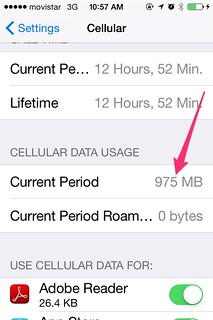

2. You can see tweets from people who are watching your meerkat stream as you broadcast, and you can answer, but those tweets are not saved when you save the video later. Further, all of your tweets are sent to your own Twitter timeline prefaced with your user name (why?), but they don't reference the meerkat stream (why not!?) so anybody looking at your Twitter stream who hasn't seen the initial | LIVE NOW | notice just thinks you're talking to yourself.

3. Instead of tweet commentary, it's better to add audio (thanks Patrick Jackson!). I had my headphones so the microphone was close by. Then I could explain what I was streaming and answer questions from people who were watching.
4. Once you've stopped broadcasting, Meerkat gives you the option of saving your video. The first time I tried, it gave me an error, but it let me try again, and then it saved. Remember that any tweets that accompanied the video are not saved. It would be nice to have the option. The 8 minute video takes up 31Mb. (It may be that that's the same amount of data that was used, Settings doesn't give exact figures.) Quality is very reasonable.
5. Patrick tells me you can only stream vertical video and that if you rotate the phone, you simply lose 2/3 of the screen. That's too bad. (I didn't try it.)
6. You don't have to have Meerkat installed in order to watch video. Of course, you do need the program (available currently only for iOS) to add tweet comments (which is only visible while it's being broadcast) or to stream your own productions. Once the broadcast is over, Meerkat does not give a lot of information about what was shown, or where you might find the video (since it is not saved anywhere except on the broadcaster's phone, if they've chosen to save it). It does tell you how many people watched. In my case, for this first meerkat, there were 11 people watching, including Patrick and some other journalists I was talking to just before the test. I couldn't figure out a way to see who those 11 were, or to follow them back. This clearly very new software.
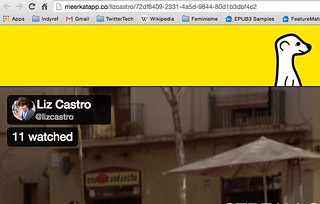
7. Wow, there are so many possibilities. As Patrick says, there are three upcoming elections in Barcelona, the city elections (which may be a bellwether for the Parliamentary turned plebescite elections for independence in September) and then the Spanish general elections later in the fall, in which many pro-independence supporters are promoting either a total boycott, or going enmasse to demand recognition of the previous independence vote. And there are always protests, and speeches, and cassolades…
Not to mention all of the cultural events, or concerts... Hmmmm.
Questions to be answered:
1. What are the legal ramifications? Do same legal rules apply about livestreaming bystanders as when photographing them?
2. How can you get more people to be involved, watching, commenting?
3. What happens if a lot of people try to meerkat the same event? How quickly before bandwidth gets jammed?
I'm sure there are many more. What do you want to know? How would you use this software? What would you like to see streamed from Barcelona?
Today, I tested Meerkat, which everybody has been talking about since it's debut (ish) at SXSW.
I went to a lovely little square in Gràcia, in the middle of Barcelona to do a test. A few things I learned:
1. It doesn't use as much data as you might think. My 8 minute video was broadcast using only 25Mb of data from my 3G network (you can test this by going to Settings > Cellular > and then checking the figures at Cellular Data Usage for the Current Period before and after you meerkat). I got a couple of "low bandwidth" warnings, but these are not reflected in the final video. I asked the people watching, and they told me that they didn't notice a lag.


2. You can see tweets from people who are watching your meerkat stream as you broadcast, and you can answer, but those tweets are not saved when you save the video later. Further, all of your tweets are sent to your own Twitter timeline prefaced with your user name (why?), but they don't reference the meerkat stream (why not!?) so anybody looking at your Twitter stream who hasn't seen the initial | LIVE NOW | notice just thinks you're talking to yourself.

3. Instead of tweet commentary, it's better to add audio (thanks Patrick Jackson!). I had my headphones so the microphone was close by. Then I could explain what I was streaming and answer questions from people who were watching.
4. Once you've stopped broadcasting, Meerkat gives you the option of saving your video. The first time I tried, it gave me an error, but it let me try again, and then it saved. Remember that any tweets that accompanied the video are not saved. It would be nice to have the option. The 8 minute video takes up 31Mb. (It may be that that's the same amount of data that was used, Settings doesn't give exact figures.) Quality is very reasonable.
5. Patrick tells me you can only stream vertical video and that if you rotate the phone, you simply lose 2/3 of the screen. That's too bad. (I didn't try it.)
6. You don't have to have Meerkat installed in order to watch video. Of course, you do need the program (available currently only for iOS) to add tweet comments (which is only visible while it's being broadcast) or to stream your own productions. Once the broadcast is over, Meerkat does not give a lot of information about what was shown, or where you might find the video (since it is not saved anywhere except on the broadcaster's phone, if they've chosen to save it). It does tell you how many people watched. In my case, for this first meerkat, there were 11 people watching, including Patrick and some other journalists I was talking to just before the test. I couldn't figure out a way to see who those 11 were, or to follow them back. This clearly very new software.

7. Wow, there are so many possibilities. As Patrick says, there are three upcoming elections in Barcelona, the city elections (which may be a bellwether for the Parliamentary turned plebescite elections for independence in September) and then the Spanish general elections later in the fall, in which many pro-independence supporters are promoting either a total boycott, or going enmasse to demand recognition of the previous independence vote. And there are always protests, and speeches, and cassolades…
Not to mention all of the cultural events, or concerts... Hmmmm.
Questions to be answered:
1. What are the legal ramifications? Do same legal rules apply about livestreaming bystanders as when photographing them?
2. How can you get more people to be involved, watching, commenting?
3. What happens if a lot of people try to meerkat the same event? How quickly before bandwidth gets jammed?
I'm sure there are many more. What do you want to know? How would you use this software? What would you like to see streamed from Barcelona?
Labels:
Meerkat,
tall screen video,
tech,
twitter,
video
Subscribe to:
Comments (Atom)

